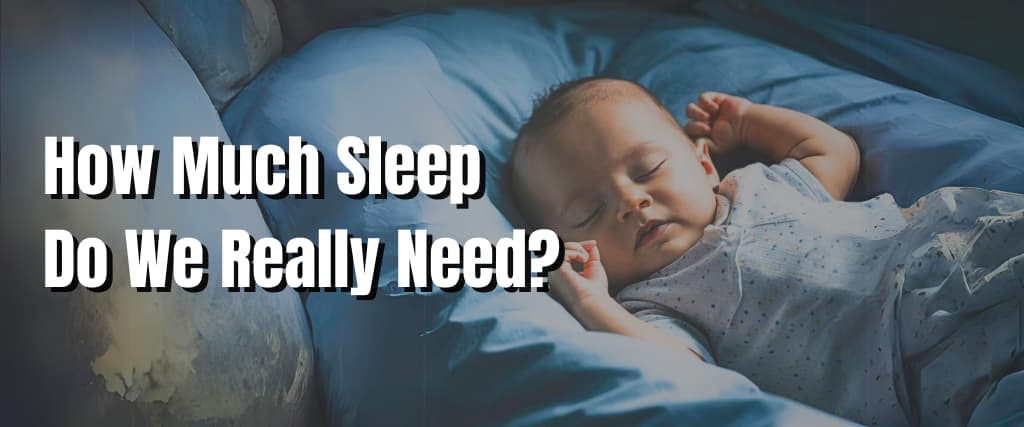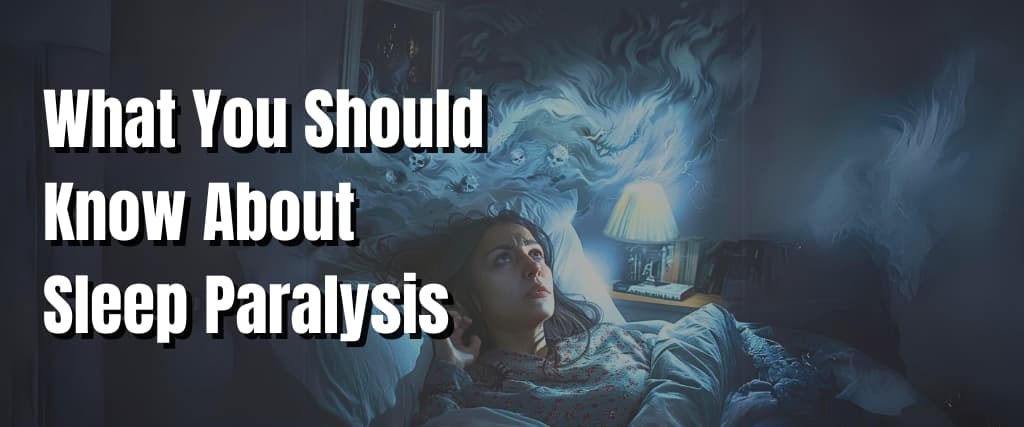Settling for the best mattress in the market can sometimes be challenging because the market is flooded with options from numerous brands. However, one of the most critical aspects of finding the right mattress is the design of the mattress.
Three main types of mattresses are available — foam, spring, and hybrid mattresses (a combination of innerspring and foam mattress designs).
The type of mattress you choose is entirely a matter of taste. Whether you enjoy sinking in your mattress or prefer sleeping on a firmer mattress, this article will guide you on some of the characteristics surrounding these two major mattress designs.
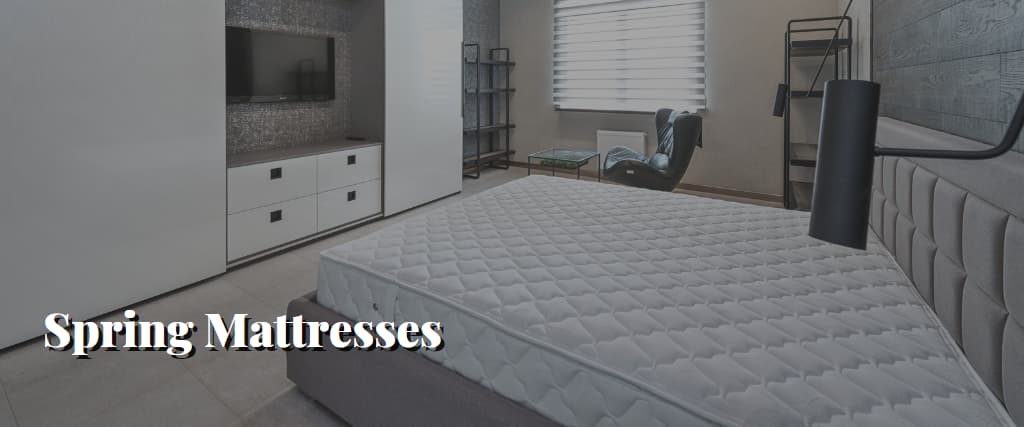
Spring Mattresses
As the name suggests, a spring mattress is a type of mattress that is made up of a core of springs or could. Also referred to as innerspring mattresses, they are usually very durable, comfortable, and bouncy. The mattress can support different weights since the springs of the mattress can conform to the sleeper’s shape.
Types of Spring Mattresses
There are different types of spring mattresses available in the market:
- Bonnell
- Pocketed
- Offset
- Continuous
Bonnell coils, which have an hourglass shape, were used in the first spring mattress sold commercially. Since they are still in use today and are inexpensive to build, innerspring mattresses using Bonnell coils tend to be less expensive.
Each coil or spring pair is wrapped individually in fabric pockets for mattresses with pocket springs, enabling each coil to operate independently. Although this lessens noise and motion transfer, models with this technique usually have higher prices.
Like pocketed springs, offset coils are more expensive to produce than Bonnell ones but have more firmness. Structure-wise, they are connected by hinged wires to offer sleepers varied support based on their need.
For example, they bend when moderate pressure is applied, but when heavier pressure is used, they push back more forcefully.
A single wire creates a collection of loose ringlets in continuous wire coils. They are stable and durable due to their tightly constructed design. They can be produced quickly and cheaply.

What is the Structural Design Behind Spring Mattresses?
The coils are linked and curved like an hourglass for a Bonnell Spring mattress, making the springs smaller in the middle. To avoid piercing any additional layers, the ends of each coil are “pigtailed” and wrapped around one another. The coils are then each connected by extremely tightly “pigtailed” wires.
Each spring in a Pocket Spring mattress is on its own and wrapped in a cotton pocket to prevent tangling or hooking on objects. Although the spring-containing pockets of fabric are attached or stitched to one another, the springs are free to move independently.
Once the coil structures have been created for both types of spring mattresses, they are surrounded on top and bottom by comfort layers. These layers may sometimes include foam, thin layers of wool, or cotton. Finally, everything is wrapped around the sides and stitched together to create the finished product.

Foam Mattresses
Typical memory foam mattresses comprise a viscoelastic foam with a polyurethane base that conforms to the sleeper’s body and relieves pressure spots. As foam retains heat, some memory foam versions have copper or gel infusions to help keep users cool while they sleep.
For better heat redistribution, gel-infused foam mattresses, for instance, have embedded gel beads. Natural or synthetic latex foam is used in latex models. Compared to conventional foam beds, they are typically denser and more resilient.
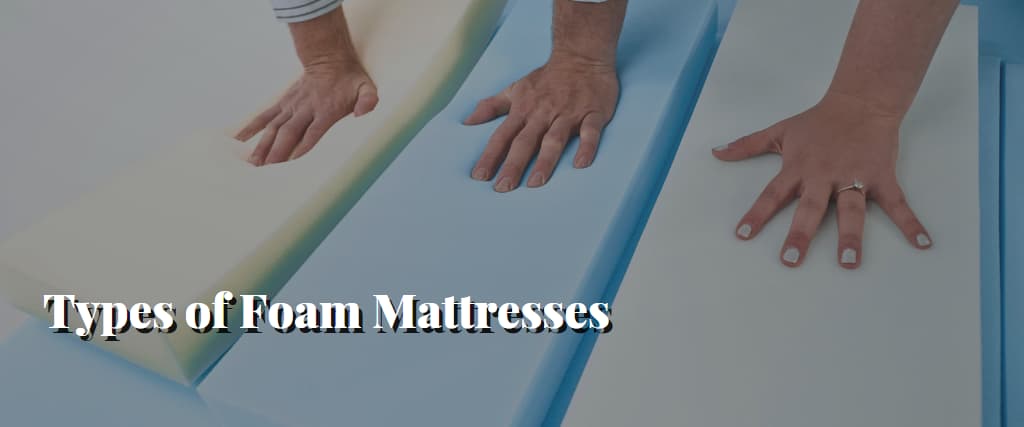
Types of Foam Mattresses
The foam categories are memory foam, Polyfoam, and latex foam. While many manufacturers may assign their foam mattresses classy names, these are only polyfoam formulas. The manufacturer will state latex or memory foam. This post will offer solutions to comprehend how the three differ.
The cost of these foam mattresses varies according to the components. While gel-infused memory foam and copper-infused foam are more expensive, Polyurethane foam, often known as polyfoam, is typically inexpensive. Similarly, latex costs more than polyurethane foam despite being a more premium material with a longer lifespan.
How are Foam Mattresses usually constructed?
Most foam mattresses available today will include at least two layers of foam. You may use any polyfoam, latex, memory, or combination for each layer.
The layers should be made to support your body and contour it simultaneously.
This allows your weight to be evenly distributed throughout the layers, relieving pressure points. The top layer or layers tend to contour more (memory foam is frequently used here rather than the core), whereas the core layers are typically latex or polyfoam.
Differences Between Spring Mattress and Foam Mattresses
1. Price
Memory foam mattresses tend to be more expensive than traditional innerspring ones. Considering that innerspring beds are made of less costly materials. Memory foam mattresses require a more expensive production process, accounting for these beds’ higher costs.
As a result of its sophisticated design, which combines foam and coils, particular spring mattresses, like hybrids, cost more than all-foam memory mattresses. However, you’ll be better positioned to buy spring mattresses than memory foam models if you’re after a budget-friendly mattress.
Below are some of the major factors affecting both models’ prices.
Spring Beds:
- Coil type: The pricing of a mattress might vary depending on the coils utilised. In general, mattresses with stronger coils will cost more money.
- Coil count: The mattress’s coil count may impact the cost. The cost of mattresses with additional coils will typically be higher.
- Comfort layers: The price might be impacted by the kind and quality of the materials used for the comfort layers. Usually, mattresses that cost more will be made of better-quality materials.
- Retailer and brand: The mattress’s retailer and brand can impact costs. Higher-end shops and more well-known brands typically charge more for their goods.
Foam Beds:
- Foma type: The foam used in the mattress might impact the cost. Typically, mattresses with better foam will cost more money.
- Foam density: The cost may vary depending on the thickness of the foam. Foams with a higher density usually cost more.
- Thickness: The pricing might also be impacted by the thickness of the foam layers. In general, thicker foam layers will cost more.
- Brand and retailer: The mattress’s brand and retailer may impact the cost. In most cases, renowned brands and upscale stores charge more for their goods.
2. Firmness
Both spring mattresses and foam beds can provide various firmness options to accommodate multiple sleeping preferences. There are some significant changes to keep in mind, though.
- Spring mattresses:
Spring mattresses generally feel firmer because of the coils’ inherent resistance. The coils’ gauge can impact the mattress’ firmness. Spring beds can also come in a variety of firmness degrees.
- Foam mattresses:
As a result of the composition of foam, foam mattresses typically provide a softer and more conforming experience. However, the degree of stiffness can vary depending on the foam type and density.
For example, when comparing latex foam to memory foam, latex can seem stiffer and more conforming. Further, stiffness can also vary depending on the thickness of the foam layers since thicker layers typically have a softer feel.

Pros and Cons Of Spring Mattress
Pros
- Better spring bounce and responsiveness, preventing you from sleeping in one position all night.
- It benefits back or stomach sleepers, heavy sleepers, or anyone who needs a certain level of support to sustain their weight.
- Hollow springs allow airflow throughout the mattress, dispersing body heat at night.
- Minimal odour as less foam is used in their construction, even though innerspring beds may still emit some off-gassing from comfort layers.
- Better edge support than foam beds, which require specific designs to factor in edge support and may still not measure up to the support offered by spring mattresses.
Cons
- Bonnell Spring mattresses transfer more motion than foam mattresses, which can disturb your sleep if your partner tosses and turns.
- Springs in mattresses can squeak as they age or if they are of a lower quality, while foam mattresses do not produce any sounds.
- Springs do not conform to your body as well as foams do, which means they may provide less pressure point relief. However, some manufacturers use different zones in their beds to match the needs of different parts of your body.
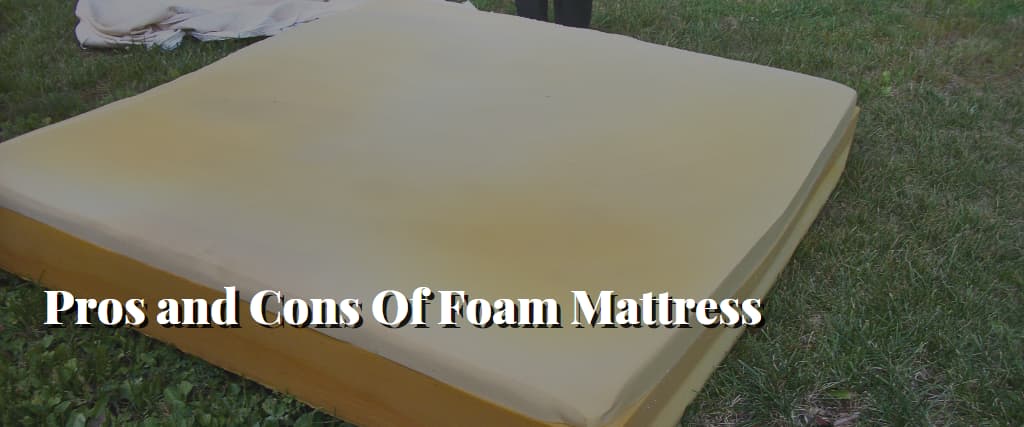
Pros and Cons Of Foam Mattress
Pros:
- Foam mattresses are highly effective at isolating motion, making them an ideal choice for couples who frequently move during the night.
- The ability of foam, especially memory foam, to conform to your body shape can provide soft yet supportive pressure relief and target pressure points.
- Soft and conforming foam can be more comfortable for side sleepers, allowing their shoulders to sink in deep.
Cons:
- Due to the small air bubbles throughout the foam block, foam mattresses have limited air circulation, making them uncomfortable for people who sleep in hot or humid environments.
- While foam’s lack of bounce is great for motion isolation, it can also make sleepers feel trapped in one position, as it’s challenging to move out of the impression of your body once you’ve sunk in.
- Foam mattresses may need more support for heavier sleepers or those who sleep on their back or stomach than innerspring mattresses.
- Even high-quality foam mattresses may release an unpleasant odour during off-gassing, which can be a health concern for some.
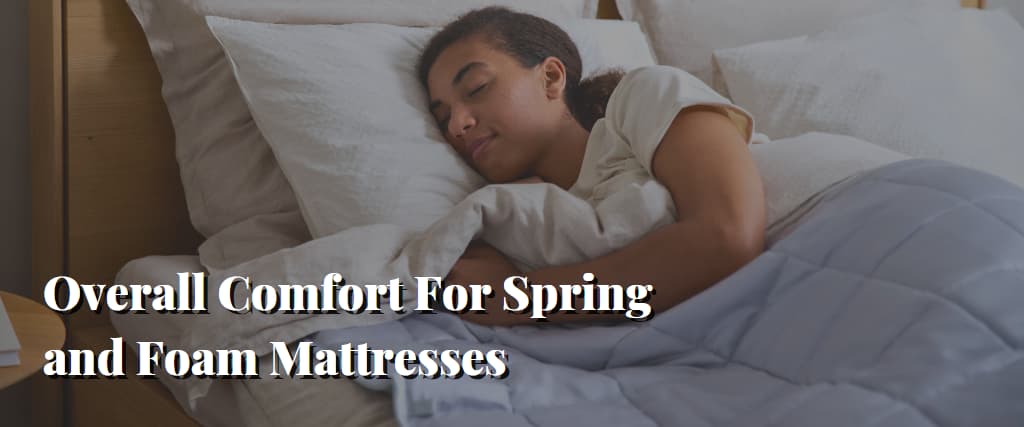
Overall Comfort For Spring and Foam Mattresses
Spring Mattresses
Spring beds’ overall comfort can be influenced by various factors such as coil type, coil count, and quality of the comfort layers. To assess the comfort level of a spring bed, you should consider the following factors:
- Coil Type: The comfort level of a spring bed can be influenced by the type of coil used. For instance, Bonnell coils provide a firm feel and may not be comfortable for some people, while pocketed coils offer better contouring and support.
- Coil Count: The number of coils in the mattress also affects its comfort. Generally, a mattress with a higher coil count offers better comfort and support.
- Comfort Layers: The quality and thickness of the comfort layers can impact the bed’s overall comfort level. High-quality materials such as memory or latex foam provide better support and comfort.
- Durability: The mattress’s durability can also impact its overall comfort level. If a mattress starts to sag or lose support over time, it becomes less comfortable to sleep on.
- Personal Preferences: Comfort is a subjective experience; what feels comfortable to one person may not be comfortable to another. If you are among those who prefer a firmer mattress for better support, these types of mattresses will probably be different from your liking since they are more cushioned than foam mattresses.
Foam Mattresses
The level of comfort provided by a foam mattress is contingent on the type and quality of foam incorporated into the mattress. To assess the comfort level of a foam mattress, you should consider the following factors:
- Type of foam: There are various kinds of foam used in mattresses, including memory foam, latex foam, and polyfoam. Memory foam is renowned for its pressure relief and conforming properties, while latex foam is recognised for its resilience and longevity.
- Density: The foam’s density is also a determining factor in the mattress’s overall comfort. Foam with a higher density typically offers greater support and contouring, whereas lower-density foam may feel less supportive and softer.
- Thickness: The thickness of the foam layers can also influence the overall comfort of the mattress. More substantial foam layers usually provide greater cushioning and support.
- Cover: The quality and type of cover used on the mattress can also contribute to overall comfort. A soft and breathable cover can enhance the mattress’s overall comfort level.
- Personal preferences: Comfort is subjective, and what is comfortable for one individual may not be the same for another. Some individuals may prefer a softer mattress for more cushioning, while others may opt for a firmer mattress for more support.
Final Thoughts
Spring mattresses and foam mattresses each have unique advantages and disadvantages. Spring mattresses are typically more affordable, and the coils inside the mattress offer more breathability, which can help regulate body temperature while sleeping. However, the springs can produce more noise and motion transfer, making them less ideal for couples or light sleepers.
On the other hand, foam mattresses, such as memory foam or latex foam, offer superior pressure relief and conform to the sleeper’s body, reducing the likelihood of motion transfer. However, foam mattresses are typically more expensive than spring mattresses and can retain heat, which may not be suitable for those who sleep hot.
Ultimately, the choice between a spring or foam mattress comes down to personal preference, budget, and sleep habits. It is essential to research and compare the different types of mattresses available and consider your specific needs to make an informed decision.




